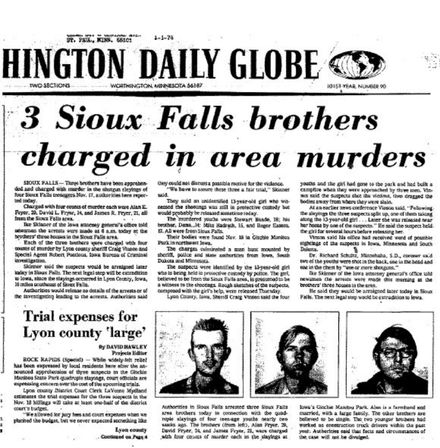In 1973, a group of five teenagers was attacked at Gitchie Manitou State Preserve in Iowa. Four were k*lled, and one was kidnapped and raped. The Fryer brothers were convicted and sentenced to life in prison for the heinous crime. The attack occurred on November 17, 1973.
In the evening of November 17, 1973, a trio of brothers attacked a group of five teenagers from Sioux Falls, South Dakota, k*lling four and kidnapping and raping one. The victims included Roger Essem(17), Stewart Baade(18), Dana Baade(14), Michael Hadrath(15), and Sandra Cheskey(13), who survived and provided crucial testimony. The attackers were identified as Allen Fryer, David Fryer, and James Fryer, all from Sioux Falls.

The m*rders
The Fryer brothers were in Gitchie Manitou State Park looking for light to shoot deer when they came into the victims singing around a campfire. David Fryer was dispatched to spy on the group and reported back to his siblings that the youngsters were in possession of marijuana. The brothers discussed their options and decided to steal the victims’ marijuana by impersonating the narcotics police. According to testimony at the trial, the Fryers reportedly believed narcotics agents might k*ll drug addicts indiscriminately.
After arming themselves with shotguns from their vehicle, Allen, James, and David Fryer positioned themselves on a ridge and unleashed a barrage of gunfire on the unsuspecting victims below. Tragically, Roger Essem was k*lled instantly while Stewart Baade suffered a serious injury. Fearing for their lives, the remaining teenagers sought refuge in nearby trees.
The Fryers then demanded that the teenagers reveal themselves, prompting Michael Hadrath and Sandra Cheskey to emerge and question their attackers. In response, Allen Fryer shot Hadrath in the arm and claimed to be a police officer. Despite being wounded, Hadrath and Cheskey were coerced into getting up by Allen Fryer, who insisted they were simply playing d*ad.
David and Allen Fryer then forced Dana Baade, Michael Hadrath, and Sandra Cheskey to follow them along a trail away from the campfire. Eventually, Sandra Cheskey was bound and placed in the victims’ van, while Stewart Baade was also taken to the van from where he had been injured.
Allen Fryer and Sandra Cheskey then drove away in the van, leaving Stewart Baade, Dana Baade, and Michael Hadrath standing near the road with James and David Fryer. Once Allen left, James and David Fryer used shotguns to murder the three teenagers. The remains were discovered the next day by a couple from Sioux Falls, SD, who were testing out their new automobile and traveled to the park. Roger Essems’ body wasn’t discovered until the next day because it was left beside the campfire, where the first encounter occurred.
Allen Fryer informed Sandra Cheskey that he was a police officer while they drove about, that he was “The Boss”, and that the other two would do as he commanded them. After a short time, James and David Fryer in the pickup met them on the road. Allen and Sandy get into the pickup and drove to a farm. James Fryer raped Sandra Cheskey at this moment. Early the next morning, Allen filled the vehicle’s tank with gasoline from a large red fuel tank and drove Cheskey home, still under the guise of being a police officer, adding that Sandra was “too young to get busted”.
Investigation
Despite Sandra Cheskey’s young age of 13 and the trauma of her experience, she maintained a calm demeanor and clear recollection of the details surrounding the rape and m*rders. However, some investigators initially doubted her credibility until she underwent multiple interviews and passed a polygraph test.
In a stroke of luck, Cheskey accompanied Sheriff Craig Vinson on a search for the farm where she was held captive and raped, and they stumbled upon Allen Fryer driving by in the same blue pickup truck used on the night of the m*rders. Cheskey identified Fryer as “the boss” and law enforcement quickly apprehended him, along with his brothers David and James.
Initially, Allen Fryer claimed that Cheskey’s friends had been the ones shooting at him and his brothers, but eventually confessed to the m*rders while trying to justify their actions as self-defense. David Fryer told a similar story at first but later changed his account to match what really happened.
Cheskey positively identified David and James Fryer in a lineup, and James Fryer tried to shift the blame to his brothers while also accusing his brother David of k*lling all four teenage boys. James was serving time in jail during the time of the m*rders but was enrolled in a work release program when he went off with his brothers instead of returning to jail.
The Fryer brothers were arraigned and charged with four counts of m*rder, and each had bond set at $400,000, totaling $100,000 for each slain boy. Allen and David Fryer were moved to Lyon County Jail in Iowa, while James Fryer remained in Sioux Falls to serve his existing sentence.
Trial
Sandra Cheskey played a crucial role in the conviction of the Fryer brothers for the m*rders of four teenage boys. Her testimony was the primary evidence presented during the 18-month trial. Although Cheskey was only 13 years old at the time of the crimes, her testimony was mostly credible. David Fryer eventually pleaded guilty to m*rder, and he was sentenced to life imprisonment without parole. In 2016, David requested the Parole Board to remove the “without possibility of parole” from his sentence, but the request was denied. Allen Fryer was found guilty of four counts of first-degree m*rder and was sentenced to four consecutive life terms in prison.
James Fryer was found guilty of three charges of first-degree m*rder and one charge of manslaughter. All three brothers were sentenced to life without the possibility of parole, and all their appeals were unsuccessful. Allen is currently serving his sentence at the Penitentiary in Anamosa, Iowa, while David and James are incarcerated at the Fort Dodge Correctional Facility in Fort Dodge, Iowa.
The Fryer brothers’ case remains a notable example of heinous crimes committed by siblings. The Fryer brothers’ trial and subsequent convictions received significant attention from the media, and the case continues to be studied by legal scholars and criminologists. The tragic m*rders of the four teenage boys and the trial that followed highlight the importance of eyewitness testimony and the challenges of obtaining reliable evidence from young witnesses. Additionally, the case underscores the need for effective rehabilitation programs within the prison system, as the Fryer brothers were all sentenced to life without the possibility of parole.
This article uses material from the Wikipedia article 1973 Gitchie Manitou murders, which is released under the Creative Commons Attribution-ShareAlike 4.0 International License

Sorry, but how the fk does this case “underscore the need for effective rehabilitation in prison?” I don’t disagree with having rehabilitation in prisons, but these shitbags are all serving life sentences. They’re not going anywhere. Who gives a damn if they’re rehabilitated?